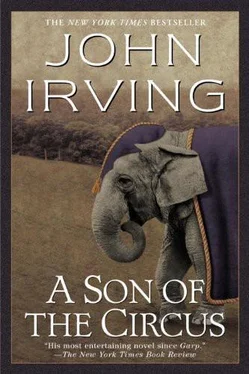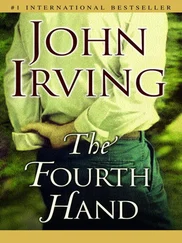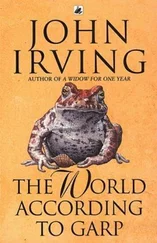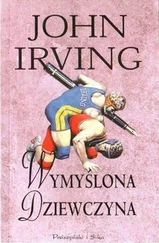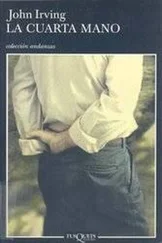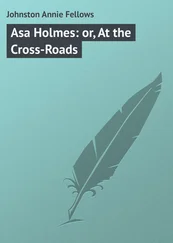John Irving - A Son of the Circus
Здесь есть возможность читать онлайн «John Irving - A Son of the Circus» весь текст электронной книги совершенно бесплатно (целиком полную версию без сокращений). В некоторых случаях можно слушать аудио, скачать через торрент в формате fb2 и присутствует краткое содержание. Город: New York, Год выпуска: 1994, ISBN: 1994, Издательство: Ballantine Book, Жанр: Современная проза, на английском языке. Описание произведения, (предисловие) а так же отзывы посетителей доступны на портале библиотеки ЛибКат.
- Название:A Son of the Circus
- Автор:
- Издательство:Ballantine Book
- Жанр:
- Год:1994
- Город:New York
- ISBN:0-679-43496-8
- Рейтинг книги:3 / 5. Голосов: 1
-
Избранное:Добавить в избранное
- Отзывы:
-
Ваша оценка:
- 60
- 1
- 2
- 3
- 4
- 5
A Son of the Circus: краткое содержание, описание и аннотация
Предлагаем к чтению аннотацию, описание, краткое содержание или предисловие (зависит от того, что написал сам автор книги «A Son of the Circus»). Если вы не нашли необходимую информацию о книге — напишите в комментариях, мы постараемся отыскать её.
, Irving’s characters transcend nationality. They are misfits—coming from everywhere, belonging nowhere. Set almost entirely in India, this is John Irving’s most ambitious novel and a major publishing event.
A Son of the Circus — читать онлайн бесплатно полную книгу (весь текст) целиком
Ниже представлен текст книги, разбитый по страницам. Система сохранения места последней прочитанной страницы, позволяет с удобством читать онлайн бесплатно книгу «A Son of the Circus», без необходимости каждый раз заново искать на чём Вы остановились. Поставьте закладку, и сможете в любой момент перейти на страницу, на которой закончили чтение.
Интервал:
Закладка:
The fate of those lesser performers who toiled for the Great Blue Nile was altogether less kind; there would be no escape for them. The elephant-footed boy had never been content to be a cook’s helper; a higher aspiration afflicted him. The knife thrower’s wife, Mrs. Bhagwan—the most mechanical of skywalkers—had failed to dissuade Ganesh from his delusions of athleticism. Despite falling many times from that model of the ladderlike device which hung from the roof of the Bhagwans’ troupe tent, the cripple would never let go of the idea that he could learn to skywalk.
The perfect ending to Farrokh’s screenplay is that the cripple learns to walk without a limp by walking on the sky; such an ending would not conclude the real Ganesh’s story. The real Ganesh wouldn’t rest until he’d tried the real thing. It was almost as Dr. Daruwalla had imagined it, almost as it was written. But it’s unlikely that the real Ganesh was as eloquent; there would have been no voice-over. The elephant boy must have looked down at least once—enough to know that he shouldn’t look down again. From the apex of the main tent, the ground was 80 feet below him. With his feet in the loops, it’s doubtful that he even thought as poetically as Farrokh’s fictional character.
(“There is a moment when you must let go with your hands. At that moment, you are in no one’s hands. At that moment, everyone walks on the sky.”) Not likely—not a sentiment that would spontaneously leap to the mind of a cook’s helper. The elephant-footed boy would probably have made the mistake of counting the loops, too. Whether counting or not counting, it’s far-fetched to imagine him coaching himself across the ladder.
(“What I tell myself is, I am walking without a limp.”) That would be the day! Dr. Daruwalla thought. Judging from where they found the cripple’s body, the real Ganesh fell when he was less than halfway across the top of the tent. There were 18 loops in the ladder; the Skywalk was 16 steps. It was Mrs. Bhagwan’s expert opinion that the elephant boy had fallen after only four or five steps; he’d never managed more than four or five steps across the roof of her tent, the skywalker said.
This news came slowly to Toronto. Mr. and Mrs. Das conveyed their regrets, by letter, to Dr. Daruwalla; the letter was late—it was misaddressed. The ringmaster and his wife added that Mrs. Bhagwan blamed herself for the accident, but she also felt certain that the cripple could never have been taught to skywalk. Doubtless her distress distracted her. The next news from Mr. and Mrs. Das was that Mrs. Bhagwan had been cut by her knife-throwing husband as she lay spread-eagled on the revolving bull’s-eye; it wasn’t a serious wound, but she gave herself no time to heal. The following night, she fell from the Skywalk. She was only as far across the top of the tent as Ganesh had been, and she fell without a cry. Her husband said that she’d been having trouble with the fourth and fifth steps ever since the elephant boy had fallen.
Mr. Bhagwan wouldn’t throw another knife, not even when they offered him a choice of targets, all of whom were small girls. The widower went into semiretirement, performing only the Elephant Passing item. There seemed to be some self-punishment about this elephant act—or so the ringmaster confided to Dr. Daruwalla. Mr. Bhagwan would lie down under the elephant—at first with fewer and fewer mattresses between his body and the elephant-walking plank, and between his body and the ground. Then he did it with no mattresses at all. There were internal injuries, the ringmaster and his wife implied. Mr. Bhagwan became ill; he was sent home. Later, Mr. and Mrs. Das heard that Mr. Bhagwan had died.
Then Dr. Daruwalla heard that they’d all become ill. There were no more letters from Mr. and Mrs. Das. The Great Blue Nile Circus had vanished. Their last place of performance was Poona, where the prevailing story about the Blue Nile was that they were brought down by a flood; it was a small flood, not a major disaster, except that the hygiene at the circus became lax. An unidentified disease killed several of the big cats, and bouts of diarrhea and gastroenteritis were rampant among the acrobats. Just that quickly, the Great Blue Nile was gone.
Had Gautam’s death been a harbinger? The old chimpanzee had died of rabies not two weeks after he’d bitten Martin Mills; Kunal’s efforts to discipline the ape by beating him had been wasted. But, among them all, Dr. Daruwalla mainly remembered Mrs. Bhagwan—her tough feet and her long black shiny hair.
The death of the elephant boy (a cripple no more) destroyed a small but important part of Farrokh. What happened to the real Ganesh had an immediate and diminishing effect on the screenwriter’s already waning confidence in his powers of creation. The screenplay of Limo Roulette had suffered from comparisons to real life. In the end, the real Ganesh’s remark rang truest. “You can’t fix what elephants do,” the cripple had said.
Like Mr. Bhagwan, who had retreated into Elephant Passing, which led to his death, the screenplay of Limo Roulette went into radical retirement. It occupied the bottommost drawer in Dr. Daruwalla’s desk at home; he wouldn’t keep a copy in his office at the hospital. If he were to die suddenly, he wouldn’t have wanted anyone but Julia to discover the unproduced screenplay. The single copy was in a folder marked
for it was Farrokh’s conviction that only John D. would one day know what to do with it.
Doubtless there would be compromises required in order for Limo Roulette to be produced; there were always compromises in the movie business. Someone would say that the voice-over was “emotionally distancing”—that was the fashionable opinion of voice-over. Someone would complain about the little girl being killed by the lion. (Couldn’t Pinky be confined to a wheelchair, but happy, for the rest of the movie?) And despite what had happened to the real Ganesh, the screenwriter loved the ending as it was written; someone would want to tamper with that ending, which Dr. Daruwalla could never allow. The doctor knew that Limo Roulette would never be as perfect as it was in those days when he was writing it and he imagined that he was a better writer than he was.
It was a deep drawer for a mere 118 pages. As if to keep the abandoned screenplay company, Farrokh filled the drawer with photographs of chromosomes; ever since Duncan Frasier had died, Dr. Daruwalla’s dwarf-blood project had passed beyond languishing—the doctor’s enthusiasm for drawing blood from dwarfs was as dead as the gay geneticist. If anything or anyone were to tempt Dr. Daruwalla to return to India, this time the doctor couldn’t claim that the dwarfs were bringing him back.
From time to time, Dr. Daruwalla would read that perfect ending to Limo Roulette —when the cripple walks on the sky—for only by this artificial means could the doctor keep the real Ganesh alive. The screenwriter loved that moment after the Skywalk when the boy is descending on the dental trapeze, spinning in the spotlight as the gleaming sequins on his singlet throw back the light. Farrokh loved how the cripple never touches the ground; how he descends into Pratap’s waiting arms, and how Pratap holds the boy up to the cheering crowd. Then Pratap runs out of the ring with Ganesh in his arms, because after a cripple has walked on the sky, no one should see him limp. It could have worked, the screenwriter thought; it should have worked.
Dr. Daruwalla was 62; he was reasonably healthy. His weight was a small problem and he’d done little to rid his diet of admitted excesses, but the doctor nevertheless expected to live for another decade or two. John D. might well be in his sixties by the time Limo Roulette was put into the actor’s hands. The former Inspector Dhar would know for whom the part of the missionary had been intended; the actor would also be relatively free of any personal attachments to the story or its characters. If certain compromises were necessary in order to produce Limo Roulette , John D. would be able to look at the screenplay objectively. Dr. Daruwalla had no doubt that the ex-Inspector Dhar would know what to do with the material.
Читать дальшеИнтервал:
Закладка:
Похожие книги на «A Son of the Circus»
Представляем Вашему вниманию похожие книги на «A Son of the Circus» списком для выбора. Мы отобрали схожую по названию и смыслу литературу в надежде предоставить читателям больше вариантов отыскать новые, интересные, ещё непрочитанные произведения.
Обсуждение, отзывы о книге «A Son of the Circus» и просто собственные мнения читателей. Оставьте ваши комментарии, напишите, что Вы думаете о произведении, его смысле или главных героях. Укажите что конкретно понравилось, а что нет, и почему Вы так считаете.
